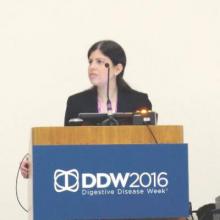SAN DIEGO – It has been challenging to identify reliable biomarkers for Lynch syndrome colorectal neoplasms, but that may be about to change. Researchers have identified 10 discriminant methylated DNA markers (MDMs) for detection of Lynch syndrome colorectal neoplasia.
In particular, OPLAH was the most discriminant MDM across all Lynch syndrome and sporadic colorectal neoplasias, according to a study reported at the annual Digestive Disease Week.
OPLAH had 100% specificity for both Lynch neoplasms and sporadic neoplasms, and sensitivity was 85% for Lynch syndrome neoplasms and 97% in sporadic patients. For adenocarcinoma, specificity and sensitivity were 100% with OPLAH.
“We found some highly discriminating and promising markers for detection of Lynch-associated neoplasms, which could complement current approaches for colorectal cancer,” said presenting author Dr. Veroushka Ballester-Vargas.
Lynch syndrome is the most common hereditary colorectal cancer (CRC), accounting for up to 5% of all CRC. Detection of Lynch neoplasms is currently challenging for several reasons, she explained.
Although there are at least three different sets of criteria for Lynch neoplasms, up to one-third of patients don’t fulfill those criteria. Moreover, 60% to 80% of Lynch tumors arise in the right colon, which is challenging to visualize on colonoscopy. Cologuard is a good test for sporadic CRC, but suboptimal for Lynch syndrome neoplasms.
Dr. Ballester-Vargas, an assistant professor at Columbia University, New York, and her colleagues have previously shown that MDMs may be advantageous as biomarkers. “These markers have one target site per gene, are highly informative and easy to assay,” she said. “Specific discovery of MDMs for Lynch-colorectal neoplasms has not been previously reported.”
Most biomarker discovery efforts have focused on sporadic colorectal neoplasia.
For discovery, the investigators evaluated 54 paraffin-embedded tissues for Lynch syndrome patients (18 normal mucosa, 18 adenoma larger than 1 cm, and 18 adenocarcinoma). Unbiased whole methylome method identified 21 top candidate MDMs from differentially methylated regions. Subsequent biological validation was performed for these 21 top candidates on 218 independent paraffin-embedded samples, 103 Lynch and 115 sporadic.
From these, the 10 most discriminant markers were selected and their performance was compared with sporadic MDMs.
“These MDMs were highly discriminant for sporadic adenoma, sporadic adenocarcinoma, and Lynch syndrome adenocarcinoma, but many were less so for Lynch,” she noted.
“Of the 10 MDMs, the key observation was that OPLAH had nearly perfect discrimination for both Lynch and sporadic neoplasms, with an area under the curve [AUC] approaching 1 – meaning 100% sensitivity and specificity for both adenoma and cancer,” she reported.
The remaining 9 MDMs were equally discriminant for adenoma and cancer but less discriminant for Lynch neoplasms.
“A closer look at OPLAH alone showed it was a highly discriminant marker, with specificity of 97% for sporadic colorectal cancer and 96% for Lynch neoplasms,” Dr. Ballester-Vargas stated.
“This is an early study. We are discussing the next steps, which will include studying MDMs in blood and stool,” she noted. “The other MDMs we identified are highly discriminant for adenomas and cancers.”
The paucity of Lynch tissues was a limitation of the study.

